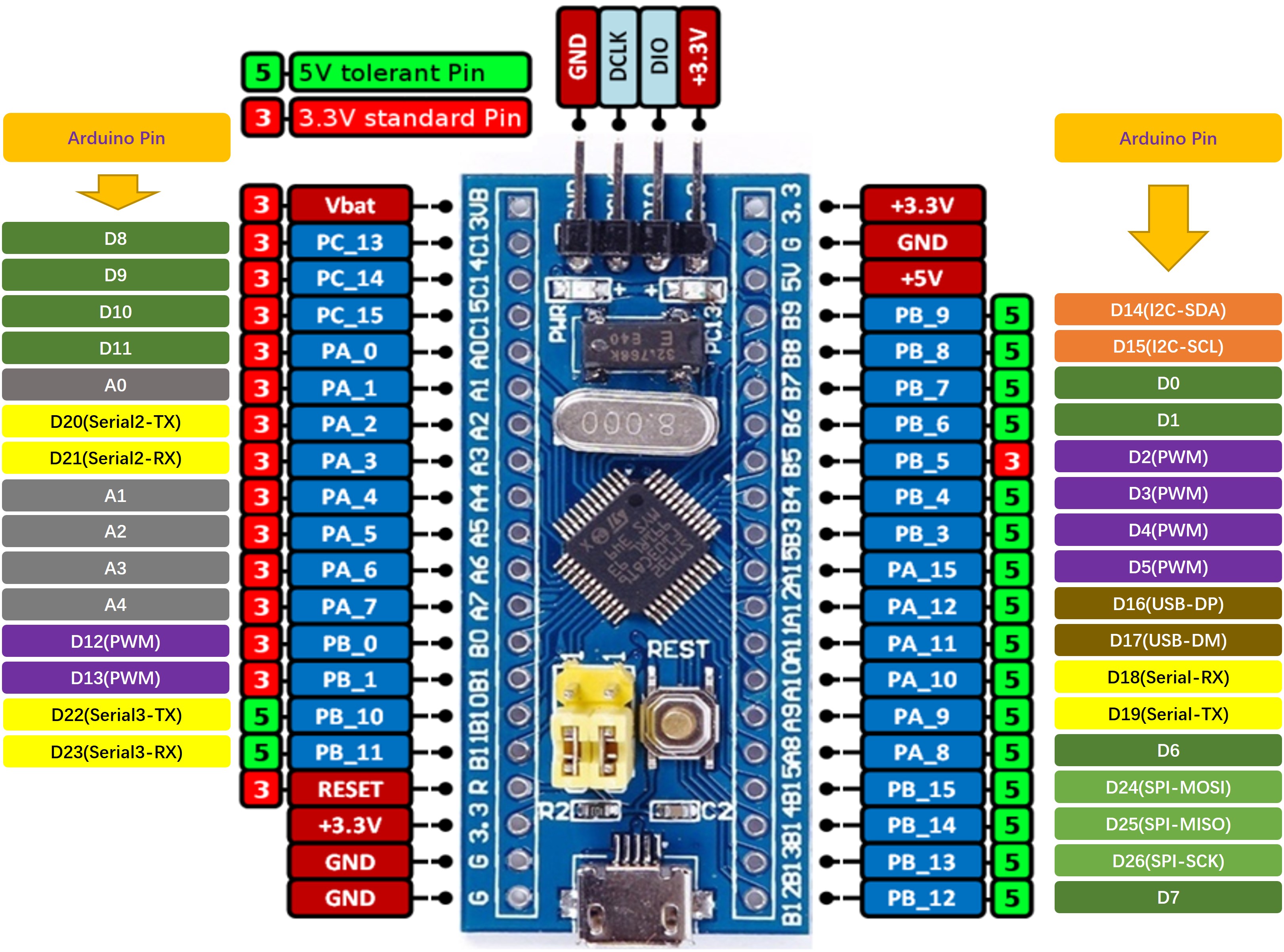|
|
||
|---|---|---|
| .. | ||
| README.md | ||
| README_zh.md | ||
| SConscript | ||
| blue-pill-f103-pinout.jpg | ||
| pins_arduino.c | ||
| pins_arduino.h | ||
README.md
The Arduino Compatible for STM32F103 Blue Pill Board
English | 中文
1 RTduino - Arduino Ecosystem Compatibility Layer for RT-Thread
STM32 Blue Pill board has support RTduino. Users can use Arduino APIs, third party libraries and programming method to program on the board.
1.1 How to Enable RTduino
Please go to the RTduino repository to see the details.
Hardware Drivers Config --->
Onboard Peripheral Drivers --->
[*] Compatible with Arduino Ecosystem (RTduino)
2 Arduino Pinout
For more information, please see pins_arduino.c and pins_arduino.h.
| Arduino Pin | STM32 Pin | 5V Tolerate | Note |
|---|---|---|---|
| 0 (D0) | PB7 | Yes | |
| 1 (D1) | PB6 | Yes | |
| 2 (D2) | PB5 | No | PWM3-CH2. Token over by RT-Thread PWM device by default |
| 3 (D3) | PB4 | Yes | PWM3-CH1. Token over by RT-Thread PWM device by default |
| 4 (D4) | PB3 | Yes | PWM2-CH2. Token over by RT-Thread PWM device by default |
| 5 (D5) | PA15 | Yes | PWM2-CH1. Token over by RT-Thread PWM device by default |
| 6 (D6) | PA8 | Yes | |
| 7 (D7, SS) | PB12 | Yes | SPI chip select by default |
| 8 (D8, LED_BUILTIN) | PC13 | No | USER LED |
| 9 (D9) | PC14 | No | |
| 10 (D10) | PC15 | No | |
| 11 (D11) | PA0 | No | |
| 12 (D12) | PB0 | No | PWM3-CH3. Token over by RT-Thread PWM device by default |
| 13 (D13) | PB1 | No | PWM3-CH4. Token over by RT-Thread PWM device by default |
| 14 (D14) | PB9 | Yes | I2C-SDA. Token over by RT-Thread I2C device by default |
| 15 (D15) | PB8 | Yes | I2C-SCL. Token over by RT-Thread I2C device by default |
| 16 (D16) | PA12 | Yes | USB-DP. Token over by TinyUSB software package by default. |
| 17 (D17) | PA11 | Yes | USB-DM. Token over by TinyUSB software package by default. |
| 18 (D18) | PA10 | Yes | Serial-Rx. Token over by RT-Thread UART device by default |
| 19 (D19) | PA9 | Yes | Serial-Tx. Token over by RT-Thread UART device by default |
| 20 (D20) | PA2 | No | Serial2-Tx. Token over by RT-Thread UART device by default |
| 21 (D21) | PA3 | No | Serial2-Rx. Token over by RT-Thread UART device by default |
| 22 (D22) | PB10 | Yes | Serial3-Tx. Token over by RT-Thread UART device by default |
| 23 (D23) | PB11 | Yes | Serial3-Rx. Token over by RT-Thread UART device by default |
| 24 (D24) | PB15 | Yes | SPI-MOSI. Token over by RT-Thread SPI device by default |
| 25 (D25) | PB14 | Yes | SPI-MISO. Token over by RT-Thread SPI device by default |
| 26 (D26) | PB13 | Yes | SPI-SCK. Token over by RT-Thread SPI device by default |
| 27 (A0) | PA1 | No | ADC1-CH1. Token over by RT-Thread ADC device by default |
| 28 (A1) | PA4 | No | ADC1-CH4. Token over by RT-Thread ADC device by default |
| 29 (A2) | PA5 | No | ADC1-CH5. Token over by RT-Thread ADC device by default |
| 30 (A3) | PA6 | No | ADC1-CH6. Token over by RT-Thread ADC device by default |
| 31 (A4) | PA7 | No | ADC1-CH7. Token over by RT-Thread ADC device by default |
| 32 (A5) | -- | ADC of chip internal reference voltage. Token over by RT-Thread ADC device by default | |
| 33 (A6) | -- | ADC of chip internal temperature. Token over by RT-Thread ADC device by default |
Notice:
- Don't use a same hardware timer to drive PWM (analogRead) and servos at same time, because hardware timers can only generate a same frequency for 4 PWM channels. Otherwise, it could cause a failure when drive servos.
3 Communication
3.1 I2C Bus
I2C bus is D14 and D15 pins. Users can directly include the #include <Wire.h>, which is the Arduino official I2C header file, to use the I2C bus.
3.2 SPI Bus
SPI bus is D24, D25 and D26 pins. Users can directly include the #include <SPI.h>, which is the Arduino official SPI header file, to use the SPI bus. In addition, chip select pin (SS) also is used, which is D7 by default.
3.3 Serial
This board supports to use Serial. method to operate uart1 device; use Serial2. method to use uart2 device; use Serial3. method to use uart3 device. See example.
3.4 USB Virtual Serial
This board supports USB virtual serial. See example. You may enable it if is needed.
RT-Thread online packages --->
Arduino libraries --->
[*] RTduino: Arduino Ecological Compatibility Layer
[*] Enable USB Serial
